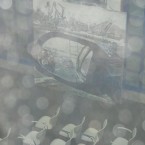SANDRA PALHARES
Secuencia imaginada. Lourdes de la Villa Liso, Bilbao, Fundación BilbaoArte Fundazioa, 2011, pp. 9-11 (erakusketaren katalogoa)
Zorioneko senti gaitezke. Gaur egungo garaia plurala da, askotarikoak teknikaren aukerak, eta, noski, anitzak eskura ditugun aurrerapen teknologikoak. Baina zertara dator hori esatea? Bada, Lourdes de la Villaren pinturari buruz ari garelako da. Bere pinturak ez du errealitatea irudikatzen, pinturaz egindako/eraikitako errealitate baten beste ikuspegi bat baizik. Eta gure mundu teknologikoki garatuan hainbestetan iragarri zaion heriotzaren ostean, bizirik zergatik irauten duen –pintura, esan nahi baita– ulertzeko arrazoia hor egon daiteke. Lourdesen obrak duen bereizitasuna pinturak bakarrik duen bereizitasuna da: margolariaren keinuak eta mantxak berezkoa duten gorabehera askoko gaitasuna.
Hori ona ala txarra den, edo arduragabea, orain garrantzirik ez du. Bakarra den gaitasun horren jabe izatea da garrantzizko, gaitasun horren bitartez bereizten delako pintura irudiak egiteko egungo gailuengandik, bere pintura ere autoerreferentziala baita, hau da, pintatzeko baliabideari buruz ere gogoeta egiten duen pintura.
Eta gainera munduari buruzko beste ikuspegi bat ematen digu.
Lehen begiratuan, pentsa dezakegu irudikatzeko bere prozesua irudia lantzeko programen bidez lortutako manipulazioari aipamena egiten ari zaiola, hain guztien eskura dagoena gaur egun ordenagailuari esker. Hala ere, antzekotasun oro kointzidentzi hutsa da. Bere irudikatzeprozesuak erreferentzia gisara erabakitzen dituen irudien etengabeko sintesian hartzen du oinarri. Irudi horiek modu etengabean eta sintetikoki manipulatzen dituenean, hainbat kasutan, bere erreferente konkretua oso abstraktua den zerbait bihur tzen da, honako aspaldiko dikotomia hau berriro azpimarratuz: konkretu/abstraktu. Mantxa egindako bere keinuek ageriko egiten dute, oso nabarmen, joko dikotomiko hori.
Nahiz eta izan badiren irudien sintesien manipulazioak, Lourdesek ez ditu photoshop bidezko manipulazioen kode berberak erabiltzen, bere sintesiprozesua ez baita ohikoa, ez da gizartearekin partekatutakoa, beste bat da berak proposatzen duena. Proposatu edo asmatu, eta horrek ez du esan nahi prozesu mekanikoaren izaera ere hartzen ez duenik, batzuetan. Dena den, mekanizazio hori ez du modu berdinberdinean errepikatzen, antzeko
zerbait da egiten duena, haren irudiko zerbait errepikatzea. Horregatik da mekanizazio bereizle bat, automatismo piktoriko bat (pinturakapak bata bestearen gainean jarriz, keinu bereizgarrien bitartez).
Prozesua, baina, dirudiena baino konplexuago da. Izan ere, bere sintesiak bere erreferente aurrekaria sinplifikatu ordez, konplexu egiten du. Batetik, errealitate edo irudimenezko konkretu bat hartzen duelako erreferente gisa, baina, bestetik, bere sintesilanak benetan osooso abstraktu den zerbait bihurtzeko aukera du –hala nola, koloremantxa, keinu eta nahasketen bidez pusketak eta zatiak estali eta gainezartzen dituenean–, hasierako plano handietako paisaiak eta pertsonaiak eraldatu egiten dira hor, eta beren aurreneko izaera ezkutatu egiten dute. Horrez gain, irudi eta pintura gainjarriaren bidezko bere manipulazioak ezereztatu egiten du oraindik ere gehiago errealitate horrekiko izan dezakeen lotura, beste errealitate bihurtuz: plastikoagoa den errealitate bat, pinturaz
betea eta ñabardura kromatikoen segidaz josia, dentsitatez libreado eta materiaz aldakorrago izan daitezkeen forma edo zeinuak eratuz, asko ere pertsonalagoa den interpretazio batera bideratuak. Hobe esate aldera, aipatu errealitate horren beste ikuspegi posible batera garamatzate. Hortaz, berriz hasierara buelta egingo genuke, pinturak gaur egun oraindik duen presentziaren arrazoietako bat hori dela gogoratzen genuen hartara hain zuzen: pinturak beste errealitate bat dotoretzen du, edo beste modu batera esanda nahiago badugu, beste izaera bat eraiki eta erakustea posible egiten du, aipatu errealitate horrentzat. Asmoa ez da pinturaren iraupena justifikatzea,
munduan pintatzen segitzeko beharra ulertzen saiatzea baizik. `Neoposexistentzialismo ´ moduko bat ezaugarri duen mundu batean, eta amaierarik gabeko nihilismo batera barneratzen dena. Animo egoera hori ez da bakarrik gaur egungo krisiaren ondorio, gizakiak betikoa baitu dena kolokan jartzeko gaitasun nekaezina. Gaur egungo krisiak gainera, egokiago egiten du. Hala ere, kointzidentzi hutsa da, beste bat, artearen bidez beti egon delako galderak egiteko aukera, ikertzeko aukera –nahiz eta, batzuetan, bilaketa hori pixka bat objektiboa dela iruditu.
Pintura garaikidetasunean, gai horri buruz honako hau esaten zuen Marlene Dumas margolariak: “Pinturaren kontra esango den guztia egia da. Anakronismo bat da. Modatik kanpo dago. Edozer zatarkeri nola egiten diguten eder erakutsi gauza itsusia da guztiz. Dekadentea da. Harrokeri hutsa. Paregabe izan nahi hori, derrigor. Lerdoa da gainera,
galdera bakarra izan eta horri ere zer erantzun ez jakitea. Arranopola, zergatik irudiei begiratzeko behar hau? Horregatik da pintatzen jarraitzen dudala”.
Lourdes de la Villak hori bera ere proposatzen digu, segi diezaiegula irudiei begiratzen. Haiek –bere pinturetako irudiek, noski– gogora ekartzen digute joan den Bilbo bat, industriala, hondatzen hasia, negukoa eta dekadentea. Beharbada, Lourdesen haurtzaroarekin lotua dagoen garaikoa, asko baitira hauriruditegi sinbolikoari egiten dizkion aipamenak, hala nola, karruselak, jostailuzko zaldia, etab. Bere paisaiak gogoratutako garaiko iluntasuna argiztatzen duen argi batek biltzen ditu –nabarmena dirudien hondamena eta dekadentzia argitzen eta zalantzan jartzen duen argi bat, itxuraz kontrajarriak diruditen munduak azaleratzen dituzten atmosferak sortuz. Nostalgiari eta iraganminaren malenkoniari egindako metafora, agian.
Gainera, batetik, isuritako tintaz, mantxaz eta pintzeladaz betetako bere oihalek espresionismo abstraktuak orain gutxi utzitako ondare moduko bat berreskuratzen dutela ematen du. Bestetik, eta kontraste modura, bereziki fotografikoak edo serigrafiatuak diren bere irudikapen ikonikoek, nahita nahiez, pop herentzia eta estetika bat gogorarazten digute. Konkretu/abstraktu haren inguruan lehen aipatu dugun joko dikotomikoari balio handiagoa ematen zaio, bere pinturaoihaletan dauden etengabeko kontrario horien bitartez: egiazko/irudizko; mekanikoki
eginak diruditen irudi erreal eta konkretuak. Eta espresiboago eta erreferentziaz libreago den automatismotik eta ustekabetik eratorritako forma abstraktuagoak. Ukaziozko jarduera etengabe hori dialektikaune baten gisara interpretatu genezake, Hegelen moduan. Filosofoa negatiboari buruz ari denean “eginkizunaz” ari da, negatiboa mugimenduaren motorra delako da, eta, ondorioz, haren bidez izakia aurka ipiniz jartzen da, kontraesanak gaindituz.
Lourdes de la Villaren pinturak itaunketa hezurmamitzen du esperientzia estetikoan, ikuskeraren estetika baten bila etengabe dabilelako, munduari eta gizakiari buruzko beste ikuspegi posible batzuei buruzko hausnarketa proposatuz, erakusketan bildu dituen obrek erakusten diguten bezala. Azken finean, ez al da hori pinturaren
jomuga: irudiak erakustea?
1. Marlene Dumas aipatzen da Marlene Dumas. Contra o muro erakusketari egindako testuan, 2010 Uztailak 02Urriak10, Serralves, Porto, Portugal
